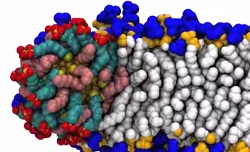 |
| A gold nanoparticle (red and green) penetrating the curved part of a model cell membrane (blue and yellow)--Courtesy of MIT |
Gold nanoparticles are once again in the drug delivery spotlight as MIT scientists have discovered a mechanism by which the particles enter cells and could thus act as better drug carriers.
Several years ago, researchers found that gold nanoparticles were capable of penetrating cell membranes and delivering drugs in a way that was less disruptive than other techniques. And now, the MIT engineers have modeled how and why this is the case, shedding light on a delivery mechanism that could help make gold nanoparticles more effective at shuttling drugs across the border.
To enter a cell, a gold nanoparticle interacts with the cell membrane in a specific way. Because of the hydrophobic and hydrophilic nature of the lipid bilayer, and because of imperfections in the membrane, there is often some open space in the membranes, according to a report from MIT. And these ultimately play into a particle's ability to make it through, leaving space in the curved areas of the cell for easier access. This discovery could give engineers a leg up in designing new gold particles with a more targeted approach.
"We've identified a type of mechanism that might be more prevalent than is currently known," lead author Reid Van Lehn said in a statement. "By identifying this pathway for the first time it also suggests not only how to engineer this particular class of nanoparticles, but that this pathway might be active in other systems as well."
Besides MIT's Van Lehn, the team comprised scientists from leading institutions in Switzerland, Italy and the U.K., making this a global effort. Companies such as AstraZeneca ($AZN) have hitched their cancer drugs to a gold nanoparticle delivery vehicle--in their case CytImmune's--to make the treatments more effective. And this kind of combination therapy could pay off down the road if researchers can find out how these particles penetrate cells and can make them do so more effectively.
"One could use the results from this paper to think about how to leverage these findings into improved nanoparticle delivery vehicles," University of Illinois at Urbana-Champaign scientist Catherine Murphy, who was not involved in the study, said in a statement. "For instance, perhaps new surface ligands for nanoparticles could be engineered to have improved affinity for both surface groups and lipid tails."
- here's the MIT report